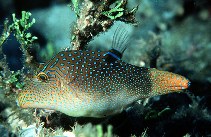| Family: |
Tetraodontidae (Puffers), subfamily: Canthigasterinae |
| Max. size: |
12.1 cm TL (male/unsexed); max.weight: 32.2 g |
| Environment: |
reef-associated; marine; depth range 10 - 36 m |
| Distribution: |
Central Pacific, including Hawaiian Islands. Indian Ocean species were re-identified as Canthigaster petersii (Ref. 123151).
Population from the Philippines, Indonesia, New Guinea, Queensland, and Belau differs in coloration (formerly Canthigaster papua);
Replaced by Canthigaster margaritata in the Red Sea. |
| Diagnosis: |
Dorsal spines (total): 0-0; Dorsal soft rays (total): 8-10; Anal spines: 0-0; Anal soft rays: 8-10. Ocellus at base of dorsal fin; dark lines radiating from eye; caudal fin brown with pale spots, outer rows may form wavy lines (Ref. 4919). |
| Biology: |
Inhabit sheltered rocky reefs (Ref. 48637). Also live in intertidal reef flats, lagoon and seaward reefs. Occur over open barren areas, also among corals and under ledges (Ref. 9710). Benthopelagic (Ref. 58302). Often found in pairs, sometimes in small groups. Feed mainly on filamentous red and green algae and coralline red algae but also on corals, tunicates, mollusks, echinoderms, polychaetes, crustaceans and bryozoans. Common (Ref. 9710). Monogamous (Ref. 52884). |
| IUCN Red List Status: |
Least Concern (LC); Date assessed: 08 June 2011 Ref. (130435)
|
| Threat to humans: |
harmless |
Source and more info: www.fishbase.org. For personal, classroom, and other internal use only. Not for publication.
